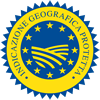Description
Prosciutto Amatriciano PGI is a charcuterie product obtained from the processing of legs of pigs belonging to the traditional Italian Large White and Landrace breeds, purebred or offspring, the Duroc breed, or other breeds compatible with the Italian Herd Book.
Production Area
The production area of Prosciutto Amatriciano PGI is within the administrative territory of 22 municipalities in the Province of Rieti, in the Lazio region, all of which are situated below 1.200 m.a.s.l.
Production Method
Processing begins by removing the fat and rind, giving the ham its traditional “pear” shape. The salting process is divided into two stages. The first involves the thighs being massaged and the skin being rubbed with sea salt, after which it is sprayed with sodium chloride. This process is always completed manually by covering the area of the stump with salt. The salted legs are then transferred to a special room and left to rest for four to six days. The legs then undergo the second stage of salting, known as "ripasso", in which the residual salt is removed from the surface and the skin is once again massaged and then rubbed and sprinkled with salt. The legs are then put back in the room to rest for 8-14 days, commencing from the start of the second salting stage. After this, the legs are washed and dried before the “sugnatura”, which involves the exposed parts of the ham being covered with a paste of pork fat, lard, cereal flour and spices. The ham is then left to cure for a period of at least 12 months, commencing from the date of the first salting stage.
Appearance and Flavour
When sliced, Prosciutto Amatriciano PGI varies from pinkish to vivid red in colour, interspersed with pure white marbling fat. It is sapid, but not salty, and has an intense fragrance that is pleasant and sweet.
History
The origins of the production of Prosciutto Amatriciano PGI date back to the Middle Ages, when this product of high commercial value was used both as a commodity and a form of payment of taxes to the Feudal lords. In 1811, the existence of a pork industry within the production area, which exported hams to nearby provinces and as far as the city of Naples, was mentioned in the Statistics of the Kingdom of Naples, known as the Statistica Murattiana. The product’s reputation continued into the 20th century, and in a text from 1932, Cesare De Berardinis describes how the preparation of this delicious product was thanks to the expertise of the Amatrice women.
Gastronomy
Prosciutto Amatriciano PGI should be kept in a cool dry place. Once deboned and sliced, it is best preserved in the refrigerator, at a temperature of between 0 and 4°C, even if it is only for a short period of time. It can be sliced by hand with a knife or with the aid of an electrical appliance. In the first case, it is advisable not to exceed a thickness of one millimetre, so as not to alter the product’s flavour. Prosciutto Amatriciano PGI is excellent as a starter or side dish, and can be eaten either on its own or accompanied by other typical charcuterie products and local cheeses. It pairs well with dry, full-bodied white wines.
Marketing
The product is marketed as Prosciutto Amatriciano PGI. It is sold whole, boned or deboned, or in slices that are vacuum-packed or in modified atmosphere packaging.
Distinctive Features
Prosciutto Amatriciano PGI boasts a specific quality that derives from the traditional trimming method that is used, which is carried out very high up on the fresh leg. This technique, which distinguishes the product from other more exposed cured hams, is thanks to the centuries of experience of the producers in the production area.












